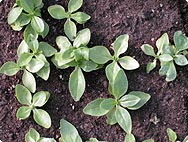
Gentiana lutea L.
Yellow Gentian

History
Gentiána is Latin and, according to Pliny and Dioscorides, refers to the last king of the Illyrian Labeatians, who are supposed to have discovered the plant's healing powers. Lutea derives from the Latin lúteus, which means ’yellow’. The Gentian root was thoroughly described by Dioscorides, Pliny, Celsus and Galen. It was regarded as a medicine against poisonous animal bites, pains in the side, liver and stomach ailments, cramps and fever. Leonhard Fuchs wrote in the 16th century: ‘In short, gentian root and the juice from it take away all kinds of constipation. Being an excellent medicine for all kinds of poison and is well tolerated by a weak stomach.

Botanical characteristics
The Gentian is a hardy plant that can live for up to 60 years. Over a period of several years, the enormous tap root forms a single basal rosette. The hollow stalk, which can grow up to 1 metre high, does not grow from the rosette until the 10th or 12th year. The large, bluish-green, broad lanceolate leaves are opposed. They bear three to ten flowers in axillary clusters. The golden yellow blossoms are wheel shaped and arranged in five-pointed corollas. The Gentian flowers from July to August.

Habitat
The
Gentian is a mountain plant and grows on mountain meadows at
altitudes between 750 and 2500 metres. It is found in the Alps
and Alpine foothill regions, in the medium altitude ranges of Central
and Southern Europe, and in Asia Minor. Gentiana lutea is the only
species of Gentian that can be cultivated to produce drugs.

Preparation
A.Vogel/Bioforce uses the fresh roots of perennial plants gathered wild to produce an alcohol mother tincture. For medicinal preparations, the roots are dug up in the spring or autumn and rapidly processed, to prevent fermentation. Fermented roots are more aromatic, but less effective, and are used in the manufacture of Gentian schnapps and other bitter liqueurs.
A.Vogel Blog – Natural and Healthy
Inspiration for a healthy life!
HERBAMARE SOUP-ER SOUPS!
DOWNLOAD YOUR FREE RECIPE BOOKLET!
8 healthy, hearty and delicious homemade soups.
Supporting a healthier happier you
“Nature is just about the best thing we’ve got!“
Alfred Vogel's guide to leading a healthy and happy life
Healthy & nutritious dinner ideas
Get new recipes in your inbox every month. Sign up now